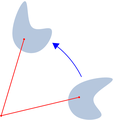Made by myself with matlab.
function main()
% prepare the screen
figure(1); clf; hold on; axis equal; axis off;
linewidth=2;
x=[0, 0.7, 0.5 1, 0]+2; y=[0, 0, 0.5, 1 0.8];
do_plot(x, y, linewidth);
theta=pi/3; A=[cos(theta) -sin(theta); sin(theta) cos(theta)];
for i=1:length(x)
v= A*[x(i); y(i)]; x(i)=v(1); y(i)=v(2);
end
do_plot(x, y, linewidth);
red=[1 0 0]; ball_radius=0.025;
x=2.1; y=0.5; plot([0 x], [0, y], 'color', red, 'linewidth', linewidth);
ball(x, y, ball_radius, red);
v= A*[x; y]; x=v(1); y=v(2); plot([0 x], [0, y], 'color', red, 'linewidth', linewidth);
ball(x, y, ball_radius, red);
ball(0, 0, ball_radius, red);
x=1.1*1.9681; y=1.1*0.9548; r=sqrt(x^2+y^2); thetas=atan2(y, x);
thetae=pi/6.2+thetas;
Theta=thetas:0.01:thetae; X=r*cos(Theta); Y=r*sin(Theta); plot(X, Y, 'linewidth', linewidth)
n=length(Theta);
arrow([X(n-1), Y(n-1)], [2*X(n)-X(n-1), 2*Y(n)-Y(n-1)], linewidth, 10, pi/6, 2, [0, 0, 1])
saveas(gcf, 'rotation_illustration.eps', 'psc2')
function do_plot(x, y, linewidth)
n=length(x);
P=5; Q=n+2*P+1; % P will denote the amount of overlap
% Make the 'periodic' sequence xp=[x(1) x(2) x(3) ... x(n) x(1) x(2) x(3) ... ]
% of length Q. Same for yp.
for i=1:Q
j=rem(i, n)+1; % rem() is the remainder of division of i by n
xp(i)=x(j);
yp(i)=y(j);
end
% do the spline interpolation
t=1:length(xp);
N=100; % how fine to make the interpolation
tt=1:(1/N):length(xp);
xx=spline(t, xp, tt);
yy=spline(t, yp, tt);
% discard the redundant pieces
start=N*(P-1)+1;
stop=N*(n+P-1)+1;
xx=xx(start:stop);
yy=yy(start:stop);
lightblue=[176,196,222]/256;
H=fill(xx, yy, lightblue);
set(H, 'linewidth', 0.001, 'edgecolor', lightblue);
function arrow(start, stop, thickness, arrowsize, sharpness, arrow_type, color)
% draw a line with an arrow at the end
% start is the x,y point where the line starts
% stop is the x,y point where the line stops
% thickness is an optional parameter giving the thickness of the lines
% arrowsize is an optional argument that will give the size of the arrow
% It is assumed that the axis limits are already set
% 0 < sharpness < pi/4 determines how sharp to make the arrow
% arrow_type draws the arrow in different styles. Values are 0, 1, 2, 3.
% 8/4/93 Jeffery Faneuff
% Copyright (c) 1988-93 by the MathWorks, Inc.
% Modified by Oleg Alexandrov 2/16/03
if nargin <=6
color=[0, 0, 0];
end
if (nargin <=5)
arrow_type=0; % the default arrow, it looks like this: ->
end
if (nargin <=4)
sharpness=pi/4; % the arrow sharpness - default = pi/4
end
if nargin<=3
xl = get(gca,'xlim');
yl = get(gca,'ylim');
xd = xl(2)-xl(1);
yd = yl(2)-yl(1);
arrowsize = (xd + yd) / 2; % this sets the default arrow size
end
if (nargin<=2)
thickness=0.5; % default thickness
end
xdif = stop(1) - start(1);
ydif = stop(2) - start(2);
if (xdif == 0)
if (ydif >0)
theta=pi/2;
else
theta=-pi/2;
end
else
theta = atan(ydif/xdif); % the angle has to point according to the slope
end
if(xdif>=0)
arrowsize = -arrowsize;
end
if (arrow_type == 0) % draw the arrow like two sticks originating from its vertex
xx = [start(1), stop(1),(stop(1)+0.02*arrowsize*cos(theta+sharpness)),NaN,stop(1),...
(stop(1)+0.02*arrowsize*cos(theta-sharpness))];
yy = [start(2), stop(2), (stop(2)+0.02*arrowsize*sin(theta+sharpness)),NaN,stop(2),...
(stop(2)+0.02*arrowsize*sin(theta-sharpness))];
plot(xx,yy, 'LineWidth', thickness, 'color', color)
end
if (arrow_type == 1) % draw the arrow like an empty triangle
xx = [stop(1),(stop(1)+0.02*arrowsize*cos(theta+sharpness)), ...
stop(1)+0.02*arrowsize*cos(theta-sharpness)];
xx=[xx xx(1) xx(2)];
yy = [stop(2),(stop(2)+0.02*arrowsize*sin(theta+sharpness)), ...
stop(2)+0.02*arrowsize*sin(theta-sharpness)];
yy=[yy yy(1) yy(2)];
plot(xx,yy, 'LineWidth', thickness, 'color', color)
% plot the arrow stick
plot([start(1) stop(1)+0.02*arrowsize*cos(theta)*cos(sharpness)], [start(2), stop(2)+ ...
0.02*arrowsize*sin(theta)*cos(sharpness)], 'LineWidth', thickness, 'color', color)
end
if (arrow_type==2) % draw the arrow like a full triangle
xx = [stop(1),(stop(1)+0.02*arrowsize*cos(theta+sharpness)), ...
stop(1)+0.02*arrowsize*cos(theta-sharpness),stop(1)];
yy = [stop(2),(stop(2)+0.02*arrowsize*sin(theta+sharpness)), ...
stop(2)+0.02*arrowsize*sin(theta-sharpness),stop(2)];
% plot the arrow stick
plot([start(1) stop(1)+0.01*arrowsize*cos(theta)], [start(2), stop(2)+ ...
0.01*arrowsize*sin(theta)], 'LineWidth', thickness, 'color', color)
H=fill(xx, yy, color);% fill with black
set(H, 'EdgeColor', 'none')
end
if (arrow_type==3) % draw the arrow like a filled 'curvilinear' triangle
curvature=0.5; % change here to make the curved part more curved (or less curved)
radius=0.02*arrowsize*max(curvature, tan(sharpness));
x1=stop(1)+0.02*arrowsize*cos(theta+sharpness);
y1=stop(2)+0.02*arrowsize*sin(theta+sharpness);
x2=stop(1)+0.02*arrowsize*cos(theta)*cos(sharpness);
y2=stop(2)+0.02*arrowsize*sin(theta)*cos(sharpness);
d1=sqrt((x1-x2)^2+(y1-y2)^2);
d2=sqrt(radius^2-d1^2);
d3=sqrt((stop(1)-x2)^2+(stop(2)-y2)^2);
center(1)=stop(1)+(d2+d3)*cos(theta);
center(2)=stop(2)+(d2+d3)*sin(theta);
alpha=atan(d1/d2);
Alpha=-alpha:0.05:alpha;
xx=center(1)-radius*cos(Alpha+theta);
yy=center(2)-radius*sin(Alpha+theta);
xx=[xx stop(1) xx(1)];
yy=[yy stop(2) yy(1)];
% plot the arrow stick
plot([start(1) center(1)-radius*cos(theta)], [start(2), center(2)- ...
radius*sin(theta)], 'LineWidth', thickness, 'color', color);
H=fill(xx, yy, color);% fill with black
set(H, 'EdgeColor', 'none')
end
Legend: (cur) = this is the current file, (del) = delete this old version, (rev) = revert to this old version.
Click on date to download the file or see the image uploaded on that date.





